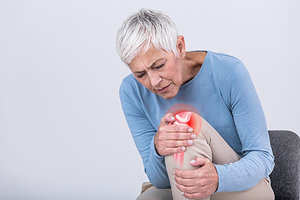Arthritis is no laughing matter, as evidenced by its prevalence in the U.S. population alone. According to the CDC, nearly one in four adults (more than 54 million people) have arthritis, and more than one in four suffer severe joint pain. Nearly 50 percent have activity limitations due to their condition.
Patients, all of whom had early- or mid-stage knee arthritis, were divided into an EA group and an observation group for comparison. Both groups took glucosamine sulfate and participated in functional training for 30 days to promote knee flexibility and stability.
For the same time period, the EA group also received electroacupuncture to GB 34 (Yanglingqua) and GB 33 (Xiyanguan) along the Shaoyang meridian, with intensity adjusted to patient tolerance, and needles retained for 30 minutes once EA began.
 Outcome measures, assessed via the Visual Analogue Scale, Lysholm knee score, Western Ontario and McMaster University Osteoarthritis Index, and range-of-motion score, categorized improvement as follows: 1) clinically controlled (elimination of joint pain; restoration of joint function); 2) significantly effective (relief of joint pain and stiffness; joint function improved); 3) effective (symptoms relieved slightly); or 4) ineffective (symptoms worsened or not improved).
Outcome measures, assessed via the Visual Analogue Scale, Lysholm knee score, Western Ontario and McMaster University Osteoarthritis Index, and range-of-motion score, categorized improvement as follows: 1) clinically controlled (elimination of joint pain; restoration of joint function); 2) significantly effective (relief of joint pain and stiffness; joint function improved); 3) effective (symptoms relieved slightly); or 4) ineffective (symptoms worsened or not improved).
More members of the EA group achieved "effective" improvement or better compared to the observation group (56 percent vs. 45 percent), leading the study authors to conclude acupuncture can reduce pain and help restore knee joint function in knee arthritis patients.
Source: Cao HB, Wang SM, Gui GF. Clinical effects of electroacupuncture along Shaoyang meridian combined with functional training on knee osteoarthritis, Chinese J Rehab Med, December 2020.
Acupuncture Today editorial staff members research, investigate and write articles for the publication on an ongoing basis. To contact the Editorial Department or submit an article of your own for consideration, email mailto:
.



